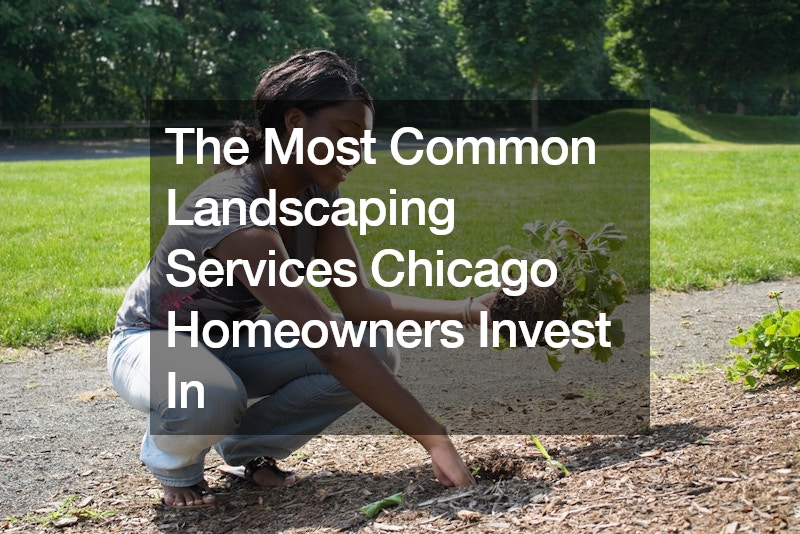Introduction
Landscaping plays a pivotal role in shaping the ambiance and functionality of residential properties in Chicago. It goes beyond mere aesthetics, encompassing aspects of environmental sustainability, property value enhancement, and personal enjoyment. For Chicago homeowners, investing in professional landscaping services is a strategic decision aimed at transforming outdoor spaces into havens of beauty and functionality. Whether through regular lawn care maintenance, intricate landscape designs, or sustainable practices, these services cater to a wide range of needs and preferences. This article explores the most common landscaping services sought by Chicago homeowners, providing comprehensive insights into their benefits and practical applications.
1. What are the benefits of professional lawn care services?

A professional lawn care company extends far beyond the basics of grass cutting. They involve a meticulous approach to lawn health and maintenance, utilizing specialized knowledge and equipment to ensure optimal results. A key benefit is the promotion of healthier lawns through expert treatments like fertilization, aeration, and weed control, which go beyond what typical homeowners might undertake on their own. These services not only enhance the visual appeal of your property but also contribute to the overall health of the soil and vegetation, creating a lush and vibrant outdoor environment.
Moreover, professional lawn care companies offer time and cost efficiencies. Homeowners benefit from saved time that would otherwise be spent on arduous lawn maintenance tasks. Professionals work efficiently, adhering to a schedule that considers seasonal variations and specific growth patterns. This proactive approach minimizes the risk of lawn stress or damage, ensuring consistent growth and appearance throughout the year. Additionally, the long-term cost savings associated with professional lawn care services are significant. Properly maintained lawns are less susceptible to diseases and weed infestations, reducing the need for expensive remedial treatments over time.
2. How often should you schedule lawn mowing services?
Determining the frequency of lawn mowing is crucial to maintaining a healthy and aesthetically pleasing lawn. Local landscaping services recommend scheduling based on seasonal factors such as precipitation rates, temperature fluctuations, and grass growth cycles specific to the Chicago region. During peak growing seasons, more frequent mowing may be necessary to prevent the lawn from becoming overgrown, which can lead to uneven growth patterns and increased susceptibility to pests and diseases. Conversely, in cooler months or during periods of drought, mowing frequency may decrease to avoid stressing the grass.
Professional recommendations emphasize a balanced approach that considers both the health of the lawn and the aesthetic preferences of homeowners. Tailored mowing schedules also take into account the type of grass species present, as different varieties have varying growth rates and maintenance requirements. By adhering to a customized mowing regimen, homeowners can ensure that their lawns remain resilient, lush, and visually appealing throughout the year, enhancing the overall curb appeal of their property.
3. What is included in landscape design services?

Landscape design services encompass a holistic approach to outdoor space transformation, beginning with in-depth consultations and meticulous planning phases. Experienced designers collaborate closely with homeowners to understand their vision, functional needs, and aesthetic preferences. This initial phase involves site analysis, where factors such as soil quality, existing vegetation, sunlight exposure, and terrain are assessed to inform the design process. Landscaping supplies are carefully selected to complement the design, ensuring both durability and visual harmony within the landscape.
Custom designs and detailed blueprints are then created to illustrate proposed layouts, plant placements, and hardscape features such as pathways, patios, and water elements. These designs are tailored to maximize usability and appeal while integrating sustainable practices and native plant species where possible. Implementation and installation phases are overseen with meticulous attention to detail, ensuring that the design vision is translated accurately into the physical landscape. Professional landscape designers coordinate with skilled contractors and utilize high-quality materials to bring the project to fruition, delivering outdoor spaces that enhance property value and homeowner satisfaction.
4. How do tree trimming and pruning benefit your property?
Tree trimming and pruning are essential practices for maintaining the health, safety, and aesthetic appeal of trees within your landscape. Beyond aesthetic considerations, proper tree trimming services contribute to the structural integrity and longevity of trees by removing dead or diseased branches that can pose safety hazards. This proactive approach mitigates risks such as falling limbs during storms or periods of high wind, safeguarding both property and inhabitants. Additionally, strategic pruning promotes healthy growth patterns and enhances the overall appearance of trees, ensuring they complement surrounding landscape features such as flower beds or pathways. Be sure to talk to your local tree services.
Regular pruning also supports tree health by improving air circulation and sunlight penetration through the canopy, which can reduce the risk of fungal infections and pest infestations. By maintaining optimal tree health, homeowners preserve the value and beauty of their landscape investments while promoting environmental sustainability. In cases where tree removal services are necessary due to disease, safety concerns, or landscape redesign, professional arborists ensure safe and efficient removal, adhering to local regulations and best practices to minimize disruption and maximize safety.
5. What are the advantages of installing an irrigation system?

An irrigation system is a transformative addition to any landscape, providing consistent hydration that promotes lush, healthy vegetation throughout the year. Beyond convenience, these systems contribute to water conservation efforts by delivering water directly to the root zones of plants, minimizing runoff and evaporation associated with traditional watering methods. In Chicago’s fluctuating climate, where periods of drought and intense heat can stress vegetation, an irrigation system ensures that lawns, gardens, and plantings receive adequate moisture to thrive.
Consistent hydration also promotes robust root development, which enhances the resilience of plants against environmental stressors and promotes overall plant health. By optimizing water usage, homeowners reduce their environmental footprint while maintaining vibrant landscapes that enhance property aesthetics and value. Modern irrigation systems can be tailored with smart technology features that monitor soil moisture levels and adjust watering schedules accordingly, further optimizing water efficiency and ensuring sustainable landscape management practices.
6. Why is seasonal clean-up important for landscaping?
Seasonal clean-up is essential for maintaining the health and beauty of your landscape throughout the year. Each season presents unique challenges and maintenance needs that, if addressed proactively through hardscape services and meticulous clean-up routines, can ensure long-term landscape health and vitality. In Chicago, where winters can be harsh and summers humid, seasonal clean-ups prepare the landscape for these extremes, reducing the risk of pest infestations, disease outbreaks, and plant stress.
Spring clean-ups focus on rejuvenating the landscape after winter dormancy, clearing debris, pruning shrubs, and preparing soil for new growth. These tasks promote early-season plant health and vigor, setting the stage for a vibrant landscape throughout the growing season. Fall clean-ups, on the other hand, prioritize debris removal, leaf mulching, and winterizing plants to protect them from cold temperatures and frost damage. By investing in seasonal clean-up services, homeowners maintain the integrity of their landscape investments while ensuring that outdoor spaces remain attractive and functional year-round.
7. What is involved in hardscaping services?

Hardscaping services encompass the design and installation of non-plant elements that enhance the functionality and visual appeal of outdoor spaces. This includes masonry supply for constructing pathways, retaining walls, and patios that define and organize the landscape. Hardscape features not only provide structural support but also create distinct areas for relaxation, entertainment, and outdoor dining, extending the usability of your property beyond the indoors.
Professional hardscape designers collaborate closely with homeowners to design layouts that harmonize with the natural surroundings and complement existing landscape elements. Retaining walls, for example, not only prevent soil erosion but also create terraced spaces for planting beds or seating areas. Patios and walkways enhance accessibility while connecting different areas of the landscape, promoting seamless transitions between outdoor living spaces. Whether integrating water features, fire pits, or decorative stonework, hardscaping services enhance the overall functionality and aesthetic appeal of your outdoor environment, creating inviting spaces for leisure and social gatherings.
8. How can landscape lighting enhance your property?
Landscape lighting serves as a transformative element that enhances both the aesthetics and functionality of outdoor spaces. Beyond illuminating pathways and entryways for enhanced security, strategic lighting highlights architectural features, trees, and garden beds, creating a captivating ambiance after sunset. LED lighting options are popular for their energy efficiency and longevity, providing cost-effective solutions that minimize energy consumption while maximizing the visual impact of your landscape.
Moreover, landscape lighting extends the usability of outdoor spaces well into the evening hours, allowing homeowners to enjoy their gardens and outdoor amenities long after sunset. Task lighting around cooking areas or seating zones enhances functionality, while accent lighting focuses attention on focal points such as sculptures or water features. By layering different types of lighting, homeowners can create depth and dimension within their landscape, transforming it into a captivating nighttime oasis that enhances curb appeal and overall property value.
9. Why invest in sustainable landscaping?
Sustainable landscaping practices not only benefit the environment but also contribute to long-term cost savings and property value enhancement. By incorporating native plants, efficient irrigation systems, and organic fertilizers, homeowners reduce water consumption and minimize the use of harmful chemicals that can impact soil health and water quality. Native plants are adapted to local climate conditions, requiring less water and maintenance while supporting local biodiversity and wildlife habitats.
Implementing sustainable practices such as composting organic waste and utilizing rainwater harvesting systems further reduces environmental impact while improving soil fertility and structure. These practices promote healthy plant growth and resilience against pests and diseases, reducing the need for synthetic pesticides and fertilizers. Over time, sustainable landscaping efforts contribute to a more balanced ecosystem within your property, fostering a harmonious relationship between natural and built environments. By prioritizing sustainability, homeowners not only enhance the beauty and functionality of their landscapes but also demonstrate responsible stewardship of natural resources for future generations.
10. How can pest control services protect your landscape?
Effective pest control services are essential for preserving the health and integrity of your landscape by mitigating common pest threats and preventing potential damage to plants and lawn areas. Integrated pest management (IPM) strategies focus on proactive measures such as monitoring pest populations, identifying pest species, and implementing targeted interventions that minimize environmental impact. By utilizing biological controls, natural predators, and selective pesticides, professionals address pest infestations while preserving beneficial insects and minimizing chemical exposure.
Common pests such as aphids, caterpillars, and grubs can quickly damage vegetation if left unchecked, compromising the overall aesthetic and health of your landscape. Professional pest control services offer tailored solutions based on the specific needs of your property, considering factors such as plant species, growing conditions, and pest lifecycle stages. Long-term pest management plans promote sustainable practices that support ecosystem balance and enhance the resilience of your landscape against recurring pest threats.
11. Why consider soil testing and amendments?
Soil testing and amendments are essential practices for maintaining optimal soil health and supporting healthy plant growth within your landscape. Soil testing provides valuable insights into nutrient management, including pH levels, nutrient deficiencies, and soil composition, which guide the application of targeted amendments and fertilizers. By addressing specific soil needs, homeowners can optimize plant nutrition and growth, ensuring that plants thrive in their intended environment.
Amendments such as compost, organic matter, and mineral supplements enhance soil fertility and structure, promoting robust root development and nutrient uptake. This results in healthier plants that are more resilient to environmental stressors such as drought, disease, and nutrient imbalances. Tailored soil amendments also improve water retention and drainage, creating a favorable growing environment for plants and reducing the risk of erosion and runoff. By investing in soil testing and amendments, homeowners establish a solid foundation for sustainable landscape management, ensuring long-term success and enjoyment of their outdoor spaces.
Conclusion
Investing in professional landscaping services is a strategic decision that enhances the beauty, functionality, and value of your home. Whether you prioritize regular lawn care, intricate landscape designs, or sustainable practices, each investment contributes to creating an outdoor environment that reflects your lifestyle and enhances your property’s appeal. By understanding the benefits and considerations associated with these common landscaping services, Chicago homeowners can make informed choices that ensure long-term enjoyment and satisfaction with their outdoor spaces. Professional landscapers not only transform landscapes but also provide expertise and support in maintaining vibrant and sustainable outdoor environments for years to come.




